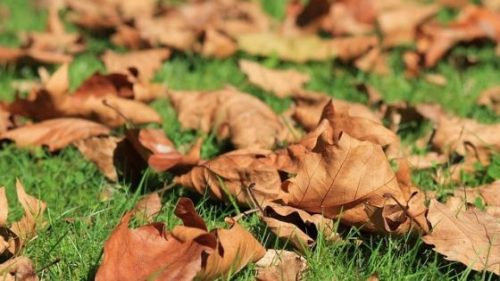Mulching leaves is often much more challenging than mulching grass. Leaves pile high, the wind blows them around the yard, and they are often wet. Finding the best mower height for mulching leaves is essential to achieving optimal results. But, what is the right height for mulching leaves?
Table of Contents
Mower Height for Mulching Leaves
If you place the mower deck height too low, an average leaf accumulation will be pushed by the front of the lawn mower instead of mulched. You want to set the mower deck above the top level of the leaves to ensure that they make it under the lawn mower deck to be mulched.
Ideally, the leaves should be mulched down so that that they fall in between the grass blades and decompose in the lawn soil. If you have a thick layer of leaves blanketing your yard, you may need to mow over them a few times to get the leaves tiny enough for fast decomposition. Be sure to lower your lawn mower deck down to your normal mowing height as you mow.
When the leaves are piled above the highest deck setting of your lawn mower, it is often easier to manually rake them in a pile and pick them up with leaf scoops or your hands. As an alternative to a rake, many people use a leaf blower to quickly establish a pile of leaves.
Check out our article on leaf clean-up options for more ideas on how to deal with your yard leaves this fall.
When to Mulch
It is best to mulch often during the fall instead of letting the leaves pile up. As previously stated, leaves that are stacked above the mowing deck will be pushed around the yard instead of mulch. Additionally, a heavy accumulation of leaves will cause a typical walk-behind self propelled mower to struggle, making raking an easier task. The leaves should be no higher than the highest mower deck setting. Ideally, you want to see the tips of the grass blades peaking through some of the leaves.
Are Mulched Leaves Good for the Grass?
Mulch leaves that are cut down to dime sized pieces will make their way into the lawn soil, break down relatively quickly, and provide nutrients for the lawn. These nutrients assist in establishing strong root growth that will help establish a greener lawn in the spring.
Furthermore, Michigan State University states that mulched leaves act as weed control. They help cover bare spots in the lawn that may easily allow weeds to grow. The university cites a potential 100 percent reduction in dandelions and crabgrass growth through leaf mulching. This helps eliminate or minimize the need for chemical weed control such as dandelion killers.
Is Bagging Better Than Mulching Leaves?
Bagging using a typical walk-behind lawn mower is an excellent option for cleaning up a minimal amount of leaves. However, once the leaves start to pile up, bagging is not an efficient method. You will find yourself stopping the lawn mower much too frequently to empty the bag to make it worth your time. Additionally, you will lose the benefit of the nutrients that mulched leaves provide if you opt to bag.

